A Spanning Tree is a tree created from a graph that contains all
of the nodes of the graph, but no cycles. In other words, you can create
a minimum spanning tree from a graph, by removing one edge from any
path that forms a cycle.
In the end, this will leave you with another graph, that is also
a tree. If this graph contains N nodes, it will contain N-1 edges.
It contains at least N-1 edges, because this many are required
to attach each node to the graph. Think of it this way. If the graph
contains 1 node, there is nothing to attach it to -- as a result, no
edges are needed. If we add nodes to the graph one at a time, we
will need to use an edge to attach the new node to the graph. If we
add a node, without adding an edge, we've really created a new graph
with only one node -- we haven't expanded the old one, because we
haven't established a relationship between the new node and any node
in the old graph.
It contains at most N-1 edges, because more than one edge
per node will create cycles, which would violate the definition of
a tree. Imagine that you have a graph, any graph, with the minimum
number, N-1, edges. Draw out your imaginary graph.
Now, try to add another edge to your graph, without creating a cycle.
You can't do it. The reason is that each node, is already connected
to another node of the graph. Adding an additional edge will connected
it to a second point on the same graph. As a result, the graph
will have a cycle -- it is no longer a tree.
Today we are going to talk about two different ways of creating
minimum spanning trees: the Depth-First Search and
the Breadth-First Search. These algorithms are going to
be very similar to the algorithms we studied for traversing trees.
The big difference is that we are going to mark the edges as we
visit them, and avoid revisiting marked nodes. This is necessary,
because graphs may have cycles -- and we don't want to go
around-and-around ground we have already covered. So, if we leave
a trail of breadcrumbs, and avoid recovering the ground we've already
walked.
We can construct a spanning tree by keeping track of the path we
follow to reach each node. In other words, we can start out with
an empty graph, in addition to the one that we want to traverse.
Then, instead of, or in addition to, printing each node we reach
during the traversal, we can also add it to the new graph, by creating
the same edge that we followed in the traversal to reach it.
So, if we get to Node-X from Node-Y, we then add an edge to Node-X from
Node-Y in our new graph. Then, in the end, the new graph has the
same nodes as the old graph -- but only one edge connecting each
pair.
Breadth First Search (BFS) searches the graph one level (one edge
away from the starting vertex) at a time. In this respect, it is very
similar to the level order traversal that we discussed for trees.
Starting at some arbitrarily chosen vertex v, we mark v so that we know
we've visited it, process v, and then visit and process all of v's
neighbors.
Now that we've visited and processed all of v's neighbors, we need to visit
and process all of v's neighbors neighbors. So we go to the first
neighbor we visited and visit all of its neighbors, then the second
neighbor we visited, and so on. We continue this process until we've visited
all vertices in the graph. We don't use recursion in a BFS because we
don't want to traverse recursively. We want to traverse one level at a time.
So imagine that you visit a vertex v, and then you visit all of v's
neighbors w. Now you need to visit each w's neighbors. How are you going
to remember all of your w's so that you can go back and visit
their neighbors? You're already marked and processed all of the w's.
How are you going to find each w's neighbors if you don't remember where
the w's are? After all, you're not using recursion, so there's no stack
to keep track of them.
To perform a BFS, we use a queue. Every time we visit vertex w's
neighbors, we dequeue w and enqueue w's neighbors. In this way, we can
keep track of which neighbors belong to which vertex. This is the same
technique that we saw for the level-order traversal of a tree. The only
new trick is that we need to makr the verticies, so we don't visit them
more than once -- and this isn't even new, since this technique was used
for the blobs problem during our discussion of recursion.
Performing a BFS on the same graph:

- We choose to start by visiting 1. (enqueue 1) [1]
- We visit 0, 2, and 3 because they are all one step away.
(dequeue 1, enqueue 0, enqueue 2, enqueue 3) [0 2 3]
- Because we visited 0 first, we go back to 0 and visit its
neighbors, 4 and 5. (dequeue 0, enqueue 4, enqueue 5) [2 3 4 5]
2 and 3 have no unvisited neighbors. (dequeue 2, dequeue 3,
dequeue 4, dequeue 5) [ ]
- We're done.
public void breadthFirstSearch(vertex v)
{
Queue q = new Queue();
v.visited = true;
q.enQueue(v);
while( !q.isEmpty() )
{
Vertex w = (Vertex)q.deQueue();
// Pritn the node or add it to the spanning tree here.
for(each vertex x adjacent to w)
{
if( !x.visited )
{
x.visited = true;
q.enQueue(x);
}
}
}
}
Finding a Minimum Spanning Tree of an Undirected, Connected Graph
A minimum spanning tree of an undirected graph is a tree formed from that
graph's edges that connects all the vertices of that graph at the lowest total
cost. You can make a spanning tree of a graph only if the graph
is connected. There may be more than one spanning tree of a particular
graph.
The number of edges in a minimum spanning tree of a graph will be the number of vertices it has - 1. A minimum spanning tree is a tree because
it's acyclic. It's spanning because it reaches every vertex in the
graph, and it's minimum for the obvious reason. If we need to wire a
house with a minimum of cable, then a we need to find a minimum spanning
tree of a graph of the electrical layout of the house.
Minimum Spanning Trees: Why Do We Care?
Many real situations can be modeled with graphs. And, many real situations
can be solved by finding the minimum spanning tree of graphs.
My favorite example involves an electrician and a house. Imagine that
a collection of electrical outlets have been installed in the walls
of a house, and that the electicity enters the house at a single electrical
box. We can model this situation as a graph, where each of the outlets
and the electrical box is a node, and the walls are the edges. The
length of each wall, or segment thereof, is the distance along the wall
between two of the electrical connections.
As a result, the electrician may have many different routes he can use
to wire the outlets -- they may be reachable by different paths along the
walls. So, the electrician wants to find the path that requires the least
amount of wire. This saves money, becuase less wire is needed. And, it
saves time, because the runs along the wal are shorter and, as a consequence,
take less time to install.
To solve this problem, the electrician can model the outlets and wall
segments conecting them as a graph rooted at the electrical box. Then,
the electrician can find the minimum spanning tree of the graph. The
edges in this tree give the paths that the electrician should use to
run the wires -- they will reach each node, while requiring the least
amount of wire.
Greedy Algorithms
Today we are going to study one algorithm for finding the
minimum spanning tree of a graph. It is known as Kruskal's Algorithm.
Kruskal's algorithm is an example of a Greedy Algorithm. Greedy
Algorithms operate by breaking a decision making process down into
small steps, and making the best decision at each step. For many problems,
this approach will lead to the best possible overall solution -- for others,
it will not.
For example, we "make change", by using a greedy algorithm. We hand back
$10 bills, until handing back another $10 would be giving back too
much money. Then we hand out $5 bills, then $1 bills, then quarters,
then dimes, then nickels, then pennies. In the end, we are guaranteed
that we have returned the correct amount of change -- with the fewest
possible bills or coins.
But, this algorithm would not work, for example, if we had 12-cent coins.
Normall, if we have to return 21-cents of change, we return
dime-dime-penny. But, with a 12-cent coin, let's call it the "dozen", we'd
return dozen-nickel-penny-penny-penny-penny. From this example, we
can see that greedy algorithms are appropriate for some problems -- but
not all problems.
But, Kruskal's Algorithm, is a greedy algorithm -- and does actually work.
Let's take a look at a different example, the sidewalk example, and
see how.
Kruskal's Algorithm
The basic algorithm is
very straight-forward. We simple attempt to add each edge from the original
graph to the minimum spanning tree, beginning with the lowest-weight edge and
finishing with the greatest-weight edge. We add the edge if it doesn't cause a
cycle and passs it up, if it does. We continue to add edges, until we've
added N-1 edges, where N is the number of verticies. Remember, spanning trees
have exactly N-1 edges -- never more, never less.
In order to make it easy to select the candidates in the right order, from
the lowest weight to the highest weight, we store the edges in a
priority queue (heap). Then, selecting an edge is simply the
deleteMin() operation.
Another way of viewing the algorithm is to views the inital
configuration as a forrest of trees, with each vertex in its own, independent
tree. If we take this view, then adding an edge merges two trees into one.
When Kruskal's terminates, there is only one tree - the minimum spanning tree.
Let's take a look at the algorithm in operation, using the smae graph as
we used last class:
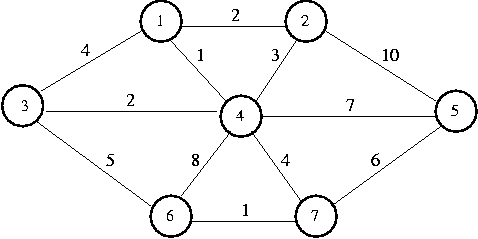
The following table shows the verticies sorted by weight and whetehr or not each vertex
was accepted. Remember, we evaluate each vertex, one-at-a-time, from the top of this list
down. In a real implemention, we would have added them to a heap, and be using deleteMin()
to get to the top one for each iteration.
| Edge
| Weight
| Action
|
| (1,4)
| 1
| Accepted
|
| (6,7)
| 1
| Accepted
|
| (1,2)
| 2
| Accepted
|
| (3,4)
| 2
| Accepted
|
| (2,4)
| 3
| Rejected
|
| (1,3)
| 4
| Rejected
|
| (4,7)
| 4
| Accepted
|
| (3,6)
| 5
| Rejected
|
| (5,7)
| 6
| Accepted
|
Using Sets to Detect Cycles
So, how can we figure out if adding a particular edge to a tree will create a
cycle? This is very important to Kruskal's Algorithm, because we only add an edge,
if doing so won't create a cycle.
Imagine that each vertex in a graph is its own set (remember the
Set class you created for the lab?).

If you connect two vertices in the same set together, you'll create
a cycle. As long as you connect vertices from two different sets, you
won't create a cycle. A and B are in different sets. I'll connect them.

Now AB is a set. Can I connect C to AB? C and AB are in different sets,
I'll connect them. Now I have a set called ABC.

Can I connect C to B? C and B are in the same set, so connecting them
will create a cycle.

Union-Find
Earlier this semester, we created a Set class using LinkedLists. This class supported
a very broad array of Set operations. But, for this particular problem, we only
need to do two things: look in a set to see if an item is there (find) and
unite two sets (union). And, since the Set lab, we've learned about trees, which
added a powerful tool to our kit. Let's see how we can use trees to represent
sets in a way that leads to efficient Union and Find operations.
Again, imagine a graph, with each vertex as its own set. Now imagine that
each set of vertices is a tree. So before we connect any edges, each vertex
is its own tree, and the graph is a forest of trees.

We'll use an array to represent the trees. Create an array, with each
index of the array representing the corresponding vertex of the graph.
Place a sentinel value, -1, into each array element. We will use this
sentinel value to denote the root of the tree. Before we connect any edges,
each vertex is its own tree, so its the root. -1 represents the root of the
tree set.
0 1 2 3 4 5 6 7
[-1] [-1] [-1] [-1] [-1] [-1] [-1] [-1]
Now I decide to connect 7 to 1. They are in different sets, so I connect them.

0 1 2 3 4 5 6 7
[-1] [-1] [-1] [-1] [-1] [-1] [-1] [ 1]
The parent of 7 is now 1, and 7 is no longer the root of the tree. If we
want to find 7's parent, we simply look at its value, which is 1. To find
1's parent, we look at its value, which is -1, indicating that 1 has no
parent and is the root of the tree.
Now I decide to connect 2 to 1. They are in different sets, so I connect them.
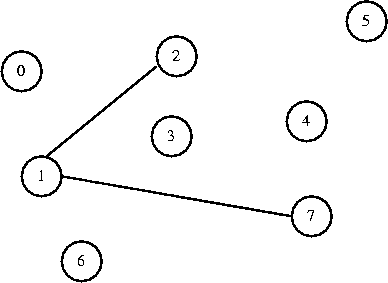
0 1 2 3 4 5 6 7
[-1] [-1] [ 1] [-1] [-1] [-1] [-1] [ 1]
Now I decide to connect 0 to 7. They are in different sets, so I connect them.
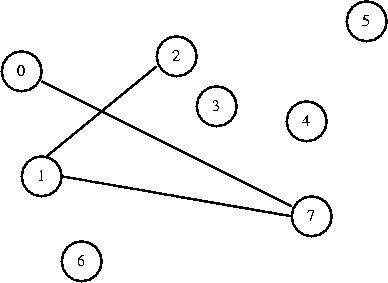
0 1 2 3 4 5 6 7
[ 7] [-1] [ 1] [-1] [-1] [-1] [-1] [ 1]
I want to connect 4 to 6. They are in different sets, so I connect them.
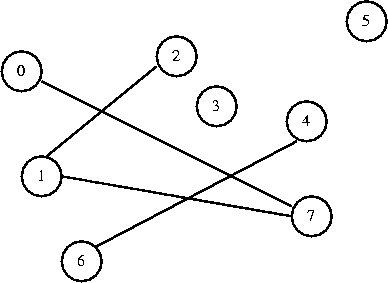
0 1 2 3 4 5 6 7
[ 7] [-1] [ 1] [-1] [ 6] [-1] [-1] [ 1]
I want to connect 5 to 6. They are in different sets, so I connect them.
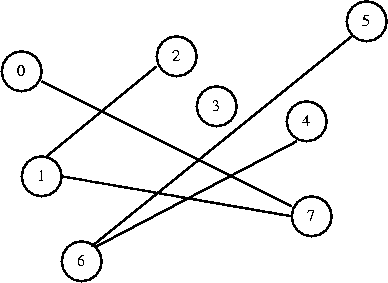
0 1 2 3 4 5 6 7
[ 7] [-1] [ 1] [-1] [ 6] [ 6] [-1] [ 1]
Note that connect 4 to 5 would now create a cycle.
I want to connect 1 to 4. They are in different sets, so I connect them.
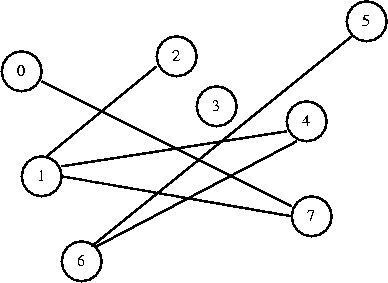
0 1 2 3 4 5 6 7
[ 7] [ 4] [ 1] [-1] [ 6] [ 6] [-1] [ 1]
How do you find out what set a particular vertex of the graph belongs to?
You simply follow its ancestors up until you find an array element with a
value of -1. At this point, all vertices except 3 are in the same set
-- 6. 6 is the only element with a value of -1. Vertex 6 is the root of
the tree consisting of all of the vertices in the graph.
The operation that connects to vertices by changing the array element
value of one to be the other is called union. The operation that
finds the root of a particular vertex's tree is called find.












